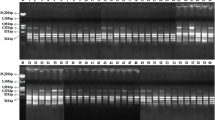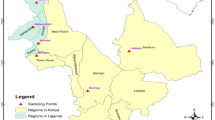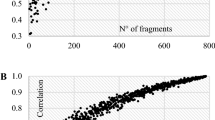Abstract
Valerianajatamansi Jones is a natural tetraploid species indigenous to the Indian Himalaya. To assess its genetic diversity and population structure, we analyzed six natural populations from the western Himalayan region using amplified fragment length polymorphism. An analysis of molecular variance found that 93% of the genetic variation of V. jatamansi was within populations and 7% among populations. The correlation between genetic and geographic distances (r = 0.14) was not significant. Though the populations are well separated, the lack of distinct genetic variation between populations may be due to either recent rapid fragmentation from a wide and continuous area resulting in genetically similar populations or wide dispersal of seed by wind, since the follicles are feathery. Polyploidy may be the reason for the lack of genetic impoverishment due to fragmentation.

Similar content being viewed by others
References
Avise JC (2004) Molecular markers, natural history, and evolution, 2nd edn. Sinauer, Sunderland, MA
Bos R, Woerdenbag HJ, Hendriks H, Friso Smit H, Wikström HV, Johannes Scheffer JC (1997) Composition of the essential oil from roots and rhizomes of Valeriana wallichii DC. Flavor Fragr J 12:123–131
Dick CW, Etchelecu G, Austerlitz F (2003) Pollen dispersal of Neotropical trees (Dinizia excelsa: Fabaceae) by native insects and African honeybees in pristine and fragmented Amazonian rainforest. Mol Ecol 12:753–764
Doyle JJ, Doyle JL (1987) A rapid DNA isolation procedure for small quantities of fresh leaf tissue. Phytochem Bull 19:1–15
Eckstein RL, O’Neill RA, Danihelka J, Otte A, Kohler W (2006) Genetic structure among and within peripheral and central populations of three endangered floodplain violets. Mol Ecol 15:2367–2379
Excoffier L, Smouse PE, Quattro JM (1992) Analysis of molecular variance inferred from metric distance among DNA haplotypes: application to human mitochondria DNA restriction sites. Genetics 131:479–491
Faivre AE, Windus JL (2002) Genetic variation among populations of Valeriana ciliata T&G. (Prairie valerian) in midwestern prairie fens. J Torrey Botan Soc 129:39–47
Grassi F, Imazio S, Gomarasca S, Citterio S, Aina R, Sgorbati S, Sala F, Patrignani G, Labra M (2004) Population structure and genetic variation within Valeriana wallrothii Kreyer in relation to different ecological locations. Plant Sci 166:1437–1441
Hamrick JL, Godt MJW (1989) Allozyme diversity in plant species. In: Brown ADH, Clegg MT, Kahler AL, Weir BS (eds) Plant population genetics, breeding, and genetic resources. Sinauer, Sunderland, MA, pp 304–319
Hamrick JL, Murawski DA, Nason JD (1993) The influence of seed dispersal mechanisms on the genetic structure of tropical tree populations. Vegetatio 107/108:281–297
Jenczewski E, Prosperi JM, Ronfort J (1999) Evidence for gene flow between wild and cultivated Medicago sativa (Leguminosae) based on allozyme markers and quantitative traits. Am J Bot 86:677–687
Kuriakose KP (1995) Genetic variability in East Indian lemongrass (Cymbopogon flexuosus Stapf). Indian Perfum 39:76–83
Levin DA (1983) Polyploidy and novelty in flowering plants. Am Nat 122:1–25
Mathela CS, Chanotiya CS, Sammal SS, Pant AK, Pandey S (2005) Compositional diversity of terpenoids in the Himalayan Valeriana genera. Chem Biodivers 2:1174–1182
Nei M, Li WH (1979) Mathematical model for studying genetic variation in terms of restriction endonucleases. Proc Natl Acad Sci USA 76:5269–5273
Peakall R, Smouse PE (2006) Genalex 6: genetic analysis in Excel. Population genetic software for teaching and research. Mol Ecol Notes 6:288–295
Perrier X, Jacquemoud-Collet JP (2006) Darwin software http://darwin.cirad.fr/darwin
Prakash V (1999) Indian Valerianaceae: a monograph on a medicinally important family. Scientific Publishers, Jodhpur
Ramsey J, Schemske DW (1998) Pathways, mechanisms and rates of polyploid formation in flowering plants. Annu Rev Ecol Syst 29:477–501
Soltis ED, Soltis PS (2000) Contributions of plant molecular systematics to studies of molecular evolution. Plant Mol Biol 42:45–75
Stebbins GL (1980) Polyploidy in plants: unsolved problems and prospects. In: Lewis WH (ed) Polyploidy, biological relevance. Plenum Press, New York
Vekemans X (2002) AFLP-SURV version 1.0. Distributed by the author. Laboratoire de Génétique et Ecologie Végétale, Université Libre de Bruxelles, Belgium
Wright S (1951) The genetical structure of populations. Ann Eugenics 15:323–354
Acknowledgment
The authors acknowledge the financial assistance from the Department of Science and Technology (SR/FT/L-99/2005), Government of India.
Author information
Authors and Affiliations
Corresponding author
Rights and permissions
About this article
Cite this article
Rajkumar, S., Singh, S.K., Nag, A. et al. Genetic Structure of Indian Valerian (Valeriana jatamansi) Populations in Western Himalaya Revealed by AFLP. Biochem Genet 49, 674–681 (2011). https://doi.org/10.1007/s10528-011-9448-2
Received:
Accepted:
Published:
Issue Date:
DOI: https://doi.org/10.1007/s10528-011-9448-2




